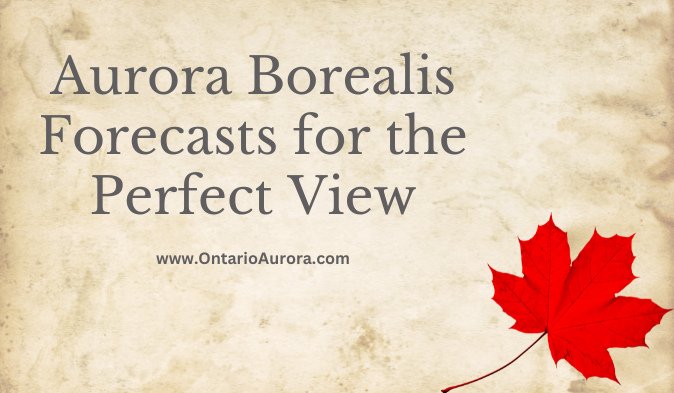
The Aurora Borealis, sometimes called the Northern Lights, is a beautiful natural event you can see at night in Canada. It is best to watch the Aurora Borealis Forecast before to view the beautiful night sky of Aurora Borealis.
The Northern Lights
The aurora borealis, which means “light of dawn,” is another name for the northern lights. People say that Galileo came up with the word in 1623.
It comes from the Greek words for “Aurora,” the goddess of dawn, and “Boreas,” the personification of the north wind.
What are the Northern Lights?
When highly charged particles in the sun’s solar wind hit air molecules in the earth’s atmosphere, they turn their energy into light, which is what you see in the northern and southern hemispheres.
This happens near the poles, where the magnetic forces come together. Around the top and bottom of our world, these magnetic fields make auroral ovals that move and change shape as the earth spins and solar flare activity rises.
Most of the time, they happen between 60 and 75 degrees latitude, which includes all of Iceland and the northern parts of Canada, Norway, Sweden, Finland, Alaska, and Russia.
The northern and southern lights, or aurora australis, happen simultaneously, but because they happen at different times of the year, they are usually not visible simultaneously.
The science behind the Northern Lights
The sun is mostly a big ball of self-luminous plasma that spins around about every 27 days. The atmosphere around the sun is called the corona, and it is a million degrees hot.
Corona holes are where the northern lights come from because they are big holes in the sun’s magnetic field that reach out into space.
The solar wind, which is made up of charged particles moving quickly, comes from these coronal holes and usually takes two to three days to reach Earth.
However, it can get there much faster after solar solid flares or coronal mass ejections (CMEs).
The charged particles then hit the earth’s magnetic field and speed up their journey to the poles along the magnetic lines. Most are deflected and go into space, but the fast ones go into the high atmosphere of Earth, where the magnetic fields come together.
This is where the particles and gases combine. Oxygen and nitrogen atoms and molecules get excited, making the light we see the northern lights. In fact, the event happens at the same time in the southern hemisphere, which is why the southern lights (aurora australis) show back-to-back.
Three interesting facts about the Northern Lights:
When the solar wind hits the Earth’s magnetic field, it makes the lights appear.
Lightning is made when charged particles from the sun hit gases in our atmosphere. The energy is released as light. Which gas is reacting with the light gives you the colours you see.
Nitrogen gives you blue and green, and oxygen gives you red. The lights that change colours and shimmer symbolize the link between the sun and Earth.
Around midnight is the best time to see the Northern Lights in Canada.
The Aurora is often brightest and most busy when the sky is darkest, between 10 pm and 3 am. People can see the aurora all year, but it’s most likely to happen around the equinoxes in March and September. Remove yourself from the city’s lights and find a clear, open space with a view of the northern sky. The show may begin slowly but can improve as the night goes on.
The Aurora changes shape and moves around like a living thing.
Don’t think that the lights in the sky will stay the same. In Canada, the Aurora is always moving, going up and down. Watch as the lights get brighter, dimmer, and then change colour. Watch as they twirl, dance, and wave.
Auroras move in a way that is fascinating and unlike anything else in nature. The Northern Lights can sometimes move so fast that you can see changes with your own eyes. It’s a beautiful display of nature’s art in motion.
Seeing the beautiful but short-lived aurora borealis light up the sky at night is a magical experience you’ll never forget.
You now know some tips on how to get the best views of the northern lights. Find a dark sky, point your camera north, and be surprised!
When is the best time to see Canada’s Northern Lights?
In March and September, the Northern Lights are most visible at these times. From late August to early April, these months are the best time to see the show. You have the best chance of seeing the Aurora during the long winter nights.
How often can Canadians see the Northern Lights?
There are always Northern Lights, but you can’t always see them with the naked eye. The Aurora Borealis gets brighter and can be seen from Earth during solar action like solar flares and coronal mass ejections.
The lights might show up almost every night when the sun is out and shining. Sightings can drop to a few times a month when only a little happens. The good news is that the sun is becoming more active right now, so catch them while you can!
Cities in Canada to see the Northern Lights
Vancouver and Toronto have bright city lights, making seeing the Northern Lights from those towns almost impossible. To see the Aurora, you’ll need to leave the city for at least an hour or two to escape all the lights. You should plan a trip to one of the abovementioned places to get the best views.
Now you know everything you need to know to see one of northern Canada’s most amazing natural sights. Make plans for your trip, pack your bags, and prepare for an exciting journey to find the beautiful northern lights.
The aurora borealis is showing mild to low activity. If the weather is good, people in many northern communities could see the northern lights straight overhead. People in the north could see them from slightly lower northern latitudes.
The beautiful auroras are ready to amaze you with their mesmerizing dance across the sky at night. Get away from the city’s bright lights, curl next to a warm fire, and look at the stars.
It was a sight you’ll never forget: the sky was full of bands of green, red, and blue light. Take advantage of the aurora borealis, which is a show of beauty from Mother Nature that you will never forget. Now, what do you wait for? You should see the northern lights!
Frequently Asked Questions (FAQs) about Aurora Borealis:
1. What are the Northern Lights, and why are they called the Aurora Borealis?
The Northern Lights, or Aurora Borealis, is a natural light display in the Earth’s polar regions caused by charged particles from the sun colliding with atmospheric gases. The name Aurora Borealis comes from the Greek words for “dawn” and “north wind,” and Galileo coined it in 1623.
2. When and where is the best time to see the Northern Lights in Canada?
The best time to witness the Northern Lights in Canada is from late August to early April, with peak visibility around the equinoxes in March and September. The lights are most active between 10 pm and 3 am. Ideal locations include northern parts of Canada, such as Iceland Alaska, and northern regions of countries like Norway, Sweden, Finland, and Russia.
3. What causes the colourful display of the Northern Lights?
The interaction of charged particles from the sun with Earth’s magnetic field creates the Northern Lights. Different gases in the atmosphere, primarily oxygen and nitrogen, emit various colors when excited. Nitrogen produces blue and green, while oxygen gives off red hues. The colours can change and shimmer, symbolizing the dynamic link between the sun and Earth.
4. Can you see the Northern Lights in cities like Vancouver and Toronto?
Cities with bright lights, such as Vancouver and Toronto, make it challenging to observe the Northern Lights. To get the best views, it’s recommended to venture outside city limits, at least an hour or two away from urban lights. Ideal locations for viewing include dark, open spaces with a clear view of the northern sky.
5. How often can Canadians witness the Northern Lights?
While the Northern Lights are always present, their visibility depends on solar activity. During periods of heightened solar flares and coronal mass ejections, sightings can occur almost nightly. However, during quieter times, sightings may drop to a few times a month. The sun’s increasing activity can enhance the chances of witnessing the Aurora Borealis.
6. What is the science behind the movement and shape changes of the Northern Lights?
The Northern Lights move and change shape due to the interaction of charged particles with Earth’s magnetic field. Near the poles, magnetic forces create auroral ovals that shift and transform as the Earth spins and solar flare activity fluctuates. The lights can exhibit dynamic movements, including twirling, dancing, and waving, creating a captivating display of nature’s art in motion.
7. How can I enhance my chances of seeing the Northern Lights in Canada?
To increase your chances of seeing the Northern Lights, choose a dark sky away from city lights, particularly during the darkest hours between 10 pm and 3 am. March and September offer optimal viewing opportunities. Stay patient; the lights may start slowly and improve as the night progresses.
8. Is there an Aurora Borealis forecast available?
Yes, Aurora Borealis forecasts are indicating the level of activity. These forecasts consider solar wind and solar flare conditions. Higher activity levels increase the likelihood of visible Northern Lights. It’s advisable to check the forecast and plan your viewing accordingly.
9. What should I bring for a Northern Lights viewing trip?
Pack warm clothing for a Northern Lights viewing trip, as temperatures can be cold, especially during winter nights. Bring a camera with a tripod to capture the mesmerizing display. Consider a trip away from city lights and find a clear, open space with a view of the northern sky for the best experience.
RELATED POSTS
View all



